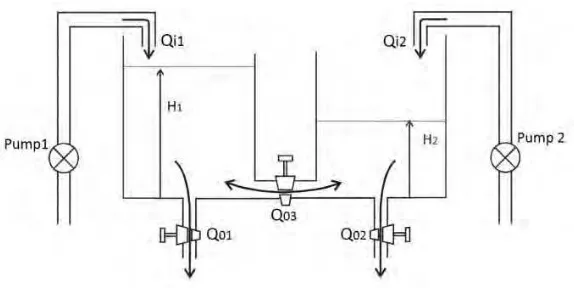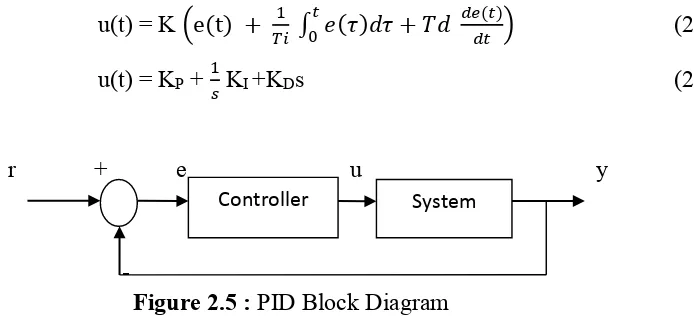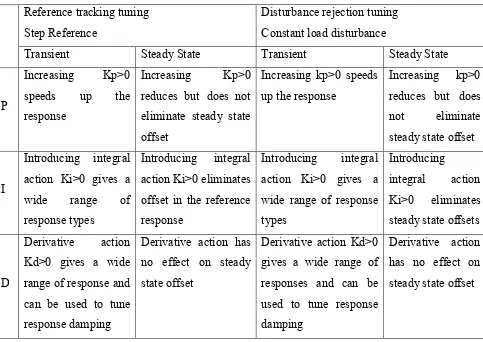i
PID CONTROL TUNING USING CUCKOO SEARCH FOR
MULTI-INPUT MULTI-OUTPUT COUPLED TANK
SYSTEM
MUHAMMAD FAIZ BIN PUNGOT
B011210056
Faculty of Electrical Engineering
Universiti Teknikal Malaysia Melaka
ii PID CONTROL TUNING USING CUCKOO SEARCH FOR MULTI-INPUT
MULTI-OUTPUT COUPLED TANK SYSTEM
MUHAMMAD FAIZ BIN PUNGOT
A report submitted in partial fulfillment of the requirements for the degree of Bachelor in Electrical Engineering (Control, Instrumentation and Automation)
Faculty of Electrical Engineering
UNIVERSITI TEKNIKAL MALAYSIA MELAKA
iii
APPROVAL
“I hereby declare that I have read this project entitle “PID Control Tuning Using Cuckoo Search for Multi-input Multi-output Coupled Tank System” and that is has comply the partial fulfillment for awarding the degree of Bachelor of Electrical Engineering (Control, Instrumentation and Automation)”
Signature : ………...
Supervisor’s Name : Puan Nur Asmiza Binti Selamat
iv
DECLARATION
I declare that this report entitle “PID Control Tuning Using Cuckoo Search for Multi-input Multi-output Coupled Tank System” is the result of my own research except as cited in the references. The report has not been accepted for any degree and is not concurrently submitted in candidature of any other degree.
Signature : ………..
Name : Muhammad Faiz Bin Pungot
v
ACKNOWLEDGEMENT
In the Name of God, the Most Beneficent, the Most Merciful. I am grateful to the Almighty for giving me the strength and the ability to complete this report.
vi
ABSTRACT
vii
ABSTRAK
viii
2.6 Cuckoo Search And Particle Swarm Optimization 10
ix
3.5 PID Control Tuning Using Optimization Technique 21
3.5.1 Cuckoo Search 22
x
LIST OF TABLES
TABLE TITLE PAGE
2.1 Tuning Effect of the PID Controller Terms 9
3.1 Parameter of CS 24
3.2 Parameter of PSO 26
4.1 Number of Nest/Particle Data 29
4.2 Limit of Bound/Max Range Data 30
4.3 Best of ITSE Data 31
4.4 Mean, Variance and Standard Deviation 32
4.5 Parameter value for CS and PSO 33
xi
LIST OF FIGURES
FIGURE TITLE PAGE
2.1 CTS-001 5
2.2 First Order Coupled Tank System 6
2.3 Second Order Coupled Tank System 6
2.4 MIMO Coupled Tank System 7
2.5 PID Block Diagram 8
3.1 Flow of Study 14
3.2 Schematic Diagram of Coupled Tank System 15
3.3 Model of MIMO Coupled Tank System Without
PID Controller 19
3.4 Model of MIMO Coupled Tank System With
PID Controller 21
3.5 CS Flowchart 23
3.6 PSO Flowchart 25
4.1 Number of Nest/Particle for CS and PSO 29
4.2 Limit of Bound/Max Range for CS and PSO 30
4.3 Best of ITSE for CS and PSO 31
xii
4.5 Tank 1 Response without PID Controller 34
4.6 Tank 2 Response without PID Controller 35
4.7 System Response Using CS 35
4.8 System Response Using PSO 35
1
CHAPTER 1
INTRODUCTION
1.1 Motivation
Coupled tank system can be found easily and widely used in industry such as food processing and industrial chemical processing. Multi-input multi-output coupled tank system (MIMO CTS) is a two tank connected each other by a valve between both tanks. It causes the water level in both tanks to interact. The water level for both tank need to be controlled. The PID controller will be apply to the MIMO CTS. The PID control tuning used in the MIMO CTS system need to be tuned in more effective and better tuning to improves the performance of the MIMO CTS. Two different optimization technique will be used in this study to obtain the parameter tuning.
1.2 Problem Statement
2
1.3 Objectives
The aim of this project is to obtain the parameter for the PID tuning for MIMO CTS using optimization technique. Therefore, the objectives are:
1. To implement the PID control tuning to MIMO coupled tank system
2. To analyze system performance in terms of rise time, peak time, overshoot percentage, settling time and fitness function between particle swarm optimization (PSO) and Cuckoo Search (CS).
1.4 Scope of Research
This study focuses on the PID control tuning in MIMO coupled tank system. The MIMO transfer function will be obtained from previous research [16]. The PID parameter will be tuned using optimization techniques which are Particle Swarm Optimization (PSO) and Cuckoo Search (CS). All simulation work will be done using MATLAB software.
1.5 Report Outlines
This report is divided into five chapters;
Chapter 1 – Introduction
This chapter describes about the project background, problem statement, objectives and scopes of this report.
Chapter 2 – Literature Review
3
Chapter 3 – Methodology
This chapter presents the flow of the study and method being used in this study. MIMO coupled tank system model and mathematical modeling of MIMO coupled tank system; the parameter value will be discussed in this chapter.
Chapter 4 – Result
This chapter shows results performance of the system using two types of controller using MIMO PID controller; between Cuckoo Search and Particle Swarm Optimization.
Chapter 5 – Conclusion
4
CHAPTER 2
LITERATURE REVIEW
2.1 Introduction
This chapter described about conceptual and previous past research on project of Multi-Input Multi-Output Coupled Tank System and PID tuning using optimization technique that related to this research paper.
2.2 Coupled tank system
Tank level control systems are easily found in our daily life. Generally many process and system depends on the tank level control systems such as industrial process, the human body and fluid handling system [1]. In the process industries, controlling the liquid level and flow between tanks is a common major issue. The process industries require liquids to be pumped, stored in tanks and pumped to another tank. The level fluid in tanks must be controlled and the flow between tanks must be regulated [1].
5
Figure 2.1: CTS-001
It consists of a Perspex tower-type tank mounted above a reservoir which functions as storage for water. The large tank is divided into two smaller tanks by a baffle plate in the center. The baffle plate can be adjusted for inter-tank flow, varying the coupling dynamic [3]. There are two types of coupled tanks system which are Single input – single output (SISO) Coupled tanks system (CTS) and Multi input – Multi output (MIMO) Coupled tanks system (CTS). Basically, coupled tank consists of two tanks connected each other by a flow channel. It makes the level of liquid in each tank to interact. Each tank has its own pump to inflow liquid.
6
Figure 2.2 : First order coupled tank system
Figure 2.3 : Second order coupled tank system
Where:
H1, H2 = height of water in tank 1 and tank 2 Qi = pump flow rate into tank
Qb = flow rate of water between tanks Qc = flow rate of water out of the tank
7
and tank 2. Each tank has its own controller, which mean that controller 1 control the flow rate of water of tank 1 and controller 2 control the flow rate of water of tank 2.
Figure 2.4 : MIMO Coupled Tank System
Where:
H1, H2 = height of water in tank 1 and tank 2 Qi1, Qi2 = pump flow rate into tank
Qo1, Qo2 = flow rate of water out of the tank 1 and tank 2 Qo3 = flow rate of water between tank
2.3 PID Controller
8
The PID controller algorithm is combination of three-term control; the proportional, the integral and derivative values, denoted as P, I, and D. The general equation or the final form of PID algorithm is; variable, u is the control signal and e is the control error. Reference variable also called the set point. The controller parameters are proportional gain K, integral time Ti, and derivative time Td.
An output value that is proportional to the current error value is produced by the proportional term. Multiplying the error by a constant Kp, called the proportional gain constant can adjusted the proportional response. For the integral term, it used to eliminate the residual steady state error that occurs with a proportional controller. Derivative used to damp oscillations. In other words, it improves settling time and stability of a system.
2.4 PID Tuning
The original technology for industrial PID controllers was analogue, and these controllers usually had a simple interface for manually tuning the controller [5]. There are two parts to tuning which are how to choose the structure of the PID controller and how to choose the numerical values for the PID coefficient or tune the controller. The purpose of PID tuning is to find the best and proper value for K,Ki and Kd. In other words is to make the system response become faster with good stability.
Controller System
9
Table 2.1 : Tuning effect of the PID controller terms
Reference tracking tuning Step Reference
Disturbance rejection tuning Constant load disturbance
Transient Steady State Transient Steady State
P
10
Meta-heuristic have been established as a standout amongst the most viable methodology to simulation optimization [7]. The applicability of meta-heuristic as a favored strategy over other optimization methods is essentially to discover great heuristic answers for complex streamlining issues with numerous nearby optima and minimal inalienable structure to guide the inquiry. The meta-heuristic methodology to tackling such issue is to begin by getting a beginning arrangement or a starting set of arrangements, and afterward starting an enhancing pursuit guided by specific principles.
There are various types of optimization techniques which are classified under meta-heuristic techniques. Most of them are inspired by nature or animal behavior [9]. One of the earliest meta-heuristic is simulated annealing (SA). It was presented by Kirkpatrick, Gelatt and Vechhi in 1983 [7] and its working standards are focused around the procedure of progressive cooling of metals in nature [9]. Genetic algorithm (GA) developed by John Holland in 1960’s and 1970’s [10]. It based on natural selection and solve complex problem [9]. Artificial bee colony (ABC) is based on the simplified models of the food searching behaviors of the bee-swarms [11]. Particle swarm optimization (PSO) is a population based stochastic and multi-agent parallel global search technique [11]. Cuckoo search (CS) is proposed by Yang and Deb in 2009. It is based on brood parasitism behavior of some cuckoo species [13].
2.6 Cuckoo Search and Particle Swarm Optimization
Cuckoo search (CS) is one of the latest nature-inspired meta-heuristic algorithms, developed by Xin-She Yang in 2009 [10]. Cuckoo is a fascinating birds, this due their aggressive reproduction strategy. Some birds when they lay their eggs in the nest, the will remove other eggs to increase the hatching probability of their own eggs. Different from cuckoo it will lay one eggs at others bird (host species) nest. Their eggs will hatch faster the host species eggs. The egg laid by a cuckoo is discovered by the host bird with the probability�� ∈ , [13]. Some host bird might throw if they found there is another egg
11
Particle swarm optimization (PSO) is developed by James Kennedy and Russell Eberhart in 1995. It is inspired by the social behavior of bird flocking and fish schooling [14]. It utilizes a population of particles that fly through the problem hyperspace with given velocities [14]. A flock animal that have no leaders will find the food by random which means when one of the animal found a food then the others will follow. The food represents the potential solutions of a problem. PSO as developed by James Kennedy and Russell Eberhart comprises a very simple concept, and paradigms can be implemented in a few lines of computer code [15].
Recent studies show that CS is potentially more efficient than PSO and genetic algorithms [13]. Other than that, the optimal solutions obtained by CS are better than the best solutions obtained by an efficient PSO [12].
2.7 Past Research
Several research have been done in previous research which involve the application of coupled tank system. The first one is Liquid Level Control of Nonlinear Coupled Tanks System Using Linear Model Predictive Control. The purpose of this research is to make a comparison usage of discrete time linear model predictive in controlling a nonlinear coupled tank system between Generalized Predictive Control and Laguerre Functions. Model Predictive Control (MPC) refers to a specific procedure in controller design from which of many kinds of algorithms can be developed for different systems, linear or nonlinear, discrete or continuous [17]. The system performance of both controllers were investigated when used to control SISO CTS and MIMO CTS. As the result, MPC using Laguerre function performs better than MPC using GPC. This due to MPC using Laguerre functions reduces computational cost.
12
measurement error [18]. Coupled tank system has been modelled and comparison between simulation study and experiment were made. The main purpose of this research is to prove that the proposed theory of the system model is correct by implements the real experiment of the system.




